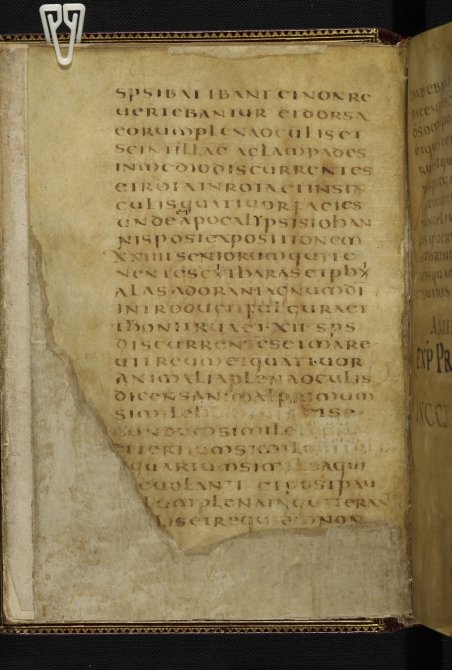By Ramona Venema
Ramona Venema works as a research assistant in the Turning Over a New Leaf project. She maintains her own cookery blog.
Today, a world without punctuation seems impossible. How could we survive without the Oxford comma? We rely on punctuation as a critical means to clarify our language and make sure we are understood. In the case of English, the use and placement of punctuation can easily change the meaning of a sentence (just as the famous internet meme shown above demonstrates). In many ways, the saying “dotting your i’s and crossing your t’s” should be replaced with “check your commas and apostrophes”. In the Middle Ages, however, people used punctuation differently (and apparently they were not as worried about eating their grandfathers)!
I’m joking of course, but punctuation was used less regularly and often served different purposes. The text in the earliest manuscripts, for example, was often meant to be read out loud and memorized. Instead of using punctuation, scribes opted to leave spaces between the words or arrange the words in a specific way to indicate where a reader could pause. Occasionally, the scribe would add a small point to separate words or chapter numbers. In the following example, the page appears to be filled with never-ending sentences, but in the middle of the page the number ‘XII’ is distinguished through the use of small dots:

British Library, Harley 1775, f. 2v – Note that the number XII has been placed between “dots” (puncti)
In the West, the development of punctuation has been credited to early Irish and Anglo-Saxon scribes, who were not initially familiar with reading Latin texts. To add extra “support” for their contemporaries reading in a foreign language, they began to add punctuation to the texts they copied. However, the marks used at this point were quite different than today.
Whereas modern punctuation marks tend to clarify syntactical functions in a sentence, during the early Middle Ages it was primarily an aid for reading out loud (helping the reader to know when to elevate his voice or pose a question, for example). As individuals began to read silently rather than orally, and Latin was learned through grammar books, punctuation became even more of a necessity.
Eventually punctuation became “trendy” — just like those who stand in line at the Apple store when the new iPhone comes out, scribes were “standing in line” to try punctuation out themselves (albeit with a couple of pointers from Isidore). By the seventh and eighth centuries every Brother Pete and John was using their own set of specialized punctuation marks. Alright, it was not always that personal, but (pre-Caroline) minuscule scripts, Visigothic and Beneventan script all presented a unique set of punctuation marks at least, with individual scribes adjusting some features as they saw fit. The way in which punctuation was applied to the text, could, in turn, customize the text itself. We owe this discovery to Malcolm B. Parkes, who, in his well-known history of punctuation, Pause and Effect, describes how a particular sentence can be explained differently through the varied use of punctuation.
Although there was a lot of variation in punctuation, there are few general marks common to many script-types.
1. The Punctus:
One of the most fundamental and most common marks is the punctus, which functioned much like the modern comma, semicolon and period. It could be fat or small and could be placed at the baseline, the middle or the headline. In simpler terms, the punctus is a dot which can take on a variety of functions and sit wherever it wants to.
2. The Punctus elevatus:
The punctus elevatus is not simply a ‘snobby punctus’ (as one may assume from its name) but an inverted semi-colon, acting as, you guessed it, a semi-colon! This punctuation mark was most common from the twelfth to the fifteenth centuries. At the end of the fifteenth century the semi-colon, as we know it today, seems to have taken over.
3. The Punctus interrogativus:
Lastly, the question mark, also known in Latin as the punctus interrogativus. This elusive mark took on many shapes, from a “lightning flash” (Truss), to “a squiggle above a period” (Reimer). It was, unsurprisingly, used to indicate the end of a question, alerting the reader to adjust the tone of his voice. The syntax of a sentence would usually indicate to the reader whether they were dealing with a question, and for this reason, they were often considered redundant additions to the page. This is why I get excited every time I see one in a manuscript, which isn’t really that often (although I have other paleographical features to get excited about as well, so don’t worry)!
Of course, there are many other punctuation marks and variations of those marks to be discovered. I suggest consulting some of the sources listed below if you’ve become curious about the punctus and his many friends.
Sources:
http://isites.harvard.edu/fs/docs/icb.topic453618.files/Central/editions/paleo.html#punct
Parkes, M. B. Pause and Effect: An Introduction to the History of Punctuation in the West. Berkeley: U of California, 1993.
Powell, James M. Medieval Studies: An Introduction. Syracuse, NY: Syracuse UP, 1976.
Reimer, Stephen R. “Manuscript Studies: Paleography: Punctuation.” Manuscript Studies: Paleography: Punctuation. University of Alberta, 20 June 2009. Web. 23 May 2014. <http://www.ualberta.ca/~sreimer/ms-course/course/punc.htm>.
Tillotson, Dianne. “Punctuation.” Medieval Writing. Dr Dianne Tillotson, 29 Feb. 2005. Web. 23 May 2014. <http://medievalwriting.50megs.com/scripts/punctuation/punctuation2.htm>.
Truss, Lynn. Eats, Shoots & Leaves: The Zero Tolerance Approach to Punctuation. New York: Gotham Books, 2003.



![A punctus elevatus sitting snugly between a [t] and an ampersand in BM Cambrai 215, f. 128](https://medievalfragments.files.wordpress.com/2014/05/bm-cambrai-2152c-f-128.jpg?w=237&h=104)

